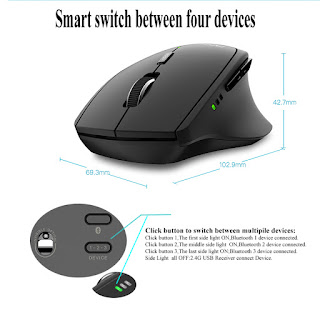I bought this obvious copy of MX Master 2S in hopes of having the device switching functionality along with a lightweight body because I have a hard time with heavy mice, like MX Master itself. Also, the ergonomics is a killer here.
But I was having a hard time figuring out how to pair it to my Linux machine, Windows 10 was fine. Literally spent hours trying to Google a solution down. Nothing was showing up. The official pages only provide links to Windows Driver and MacOS drivers. The user manual is more of a translation tutorial rather than something useful. Really really hard to read with such small fonts as well.
But fortunately, switching the search term turned up with a russian blog post that had instructions for it. And an undocumented (or hard to find in the documentation) feature is all I needed. So I am going to post that here in order to keep a record and hope someone else does not have the same hard time.
Things to know:
- The device switcher button on the mouse has a "long press" functionality. It puts the specific responder on so the device tries to connect with that.
- You need to install 'hcitool" from AUR
- First need to find out the MAC Address of the Bluetooth device. To do that, in your terminal type
hcitool scan
- With your mouse turned on, long press the device switcher button. You will see that the device number blinker slows down and blink with less frequency. This is, according to the manual, when the mouse is trying to connect to a device
- At this point, the hcitool command should turn up with a MAC Address
- Now in terminal, type
bluetoothctl
- Now type
trust <MAC Address>
- And type
connect <MAC Address>
- At this point, your mouse should be working already
Under Windows 10, no problems arose - I turned it on, clicked the "bluetooth scan" on the mouse, Windows found it and that's it.
Under Linux Mint 17.3 Cinnamon - the mouse is visible, but when trying to connect, it is impossible to enter pin code "0000" for this mouse in the pop-up notification. Accordingly, the BT manager has a mouse, but it is indicated that the pairing did not occur. Probably no problem under KDE or other shells.
The solution is that you need to manually pair:
1. Install the packages:
apt-get install bluez-tools
apt-get install bluez-hcidump
The first one swears that it is "untrusted".
2. Execute, on the mouse, press the "bluetooth" button for recognition:
hcitool scan
Scanning ...
6C: 5D: 63: 77: 1D: 1E RAPOO BT3.
3. In a new terminal window:
sudo hcidump -at
HCI sniffer - Bluetooth packet analyzer ver 2.5
device: hci0 snap_len: 1500 filter: 0xffffffffffffffff
UPDATE for those who have Mint 19 / Ubuntu 18.04:
Although the mouse is detected in the bluetooth manager, it still does not want to connect at point-blank range. Simple-agent and the commands associated with it no longer work
in bluez-tools .
To connect, enter:
hcitool scan - and hold down the channel selection button (on Rapoo 750S), we see the mouse:
Scanning ...
6C: 5D: 63: 76: AA: 17 RAPOO BT3.0 MS



No comments:
Post a Comment
Post your comment here. If you want to say something about programming problems, scripts, software etc, please try to be as descriptive as possible.